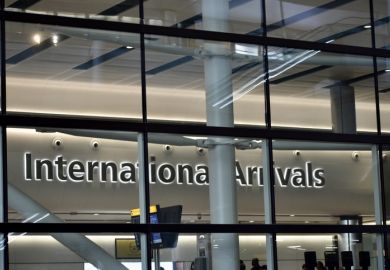It is “fine” for foreign students to make up almost half of the enrolments at a comprehensive public university, according to the boss of Australia’s most highly ranked institution.
University of Melbourne vice-chancellor Duncan Maskell said his team had undertaken “a very big, very thorough analysis” of the optimum institutional size and proportion of international enrolments it needed to achieve its academic mission, given Australia’s funding settings.
“That’s what we’re driving towards,” he told the Australian Financial Review Higher Education Summit in Sydney. “[For] a hard cap…to be brought in all of a sudden blows a lot of that out of the water.”
Universities with large overseas cohorts are expected to be most affected by the government’s proposed international enrolment caps, details of which have been promised within a week. Asked whether Melbourne’s current 46 per cent share of international students was appropriate, Professor Maskell said he thought it was “fine”.
“[Governments] were…very happy that we should be successful in getting international student income in. And then, all of a sudden, the policy settings change. To suddenly do an about-turn like that is really very difficult. We’ve got to be very careful when we have those kinds of flip-flops going on.”
International education policy dominated a conference that drew contributions from both the education minister and his opposite number. University of Tasmania vice-chancellor Rufus Black said visa processing arrangements and Chinese preference patterns were “misallocating international students around the nation”.
“Chinese students [are] flowing in very large numbers to a smaller number of universities,” Professor Black said. “The impact that has on the way the visa processing system works…has driven a kind of winner-takes-all model.”
Chinese students also fund a large chunk of Australia’s research effort, he added. “Mortgaging a very large part of our international research budget to a competitor country…is just not a strategically smart thing to do. I don’t think it’s unreasonable for a nation to decide it wants to make choices about what level of migration it manages, and students are a part of that mix.”
But the conference heard that international students cross-subsidised more than research. “We have…a distorted funding model where we do not fund universities to do what the government asks,” said Group of Eight chief executive Vicki Thomson.
University of Sydney vice-chancellor Mark Scott said no new public universities had been created in recent decades because the “government stopped writing cheques” to cover their establishment costs. He said neither domestic nor international students now appeared likely to generate the “income streams” needed to develop new institutions.
Matt Durnin, Toronto-based principal of consultants Nous Group, said Canada’s recent implementation of international enrolment caps illustrated the risks for Australian universities.
“It’s played out in a particularly messy way,” he told the conference. “We were looking at potentially a 35 per cent decrease in the number of study permits issued this year [in Canada]. Most of the universities I’m working with think they’ll come 30 per cent short of their cap, because the damage to the market and the reputation has been so large.”
Caps are not the Australian sector’s only concern, the conference heard. Phil Honeywood, chief executive of the International Education Association of Australia, said Australia’s student visas were now 10 times the cost of their Canadian equivalents following a recent fee hike to bankroll domestic reforms recommended by the Universities Accord panel.
“This is a blatant cross-subsidisation exercise that came out of nowhere, with A$900 [£466] extra on top of what was already the second-highest student visa in the world,” Mr Honeywood told the conference.
Monash University vice-chancellor Sharon Pickering said that before the coronavirus pandemic, international students had typically applied to “a few universities” within a single country. Now, the data indicated that most were applying to multiple universities in multiple countries.
“Wherever we make it harder, messier and more unpredictable, we are more likely to end up in a situation like Canada,” Professor Pickering warned.
She said the Australian sector had “collectively held its breath” and pursued a business-as-usual approach, envisaging 2025 as the year that it would fully recover from the pandemic and be “able to move forward”. The government’s international education crackdown “destabilises us at precisely that point”, she said.
“I…think there is an assumption that somehow we can again hold our breath and just get through this,” she said. “We will do our absolute level best. We have adapted to some of the most confused policymaking of any sector in the country. But we have got relatively few places to go.”




